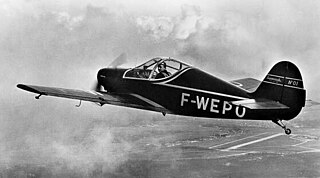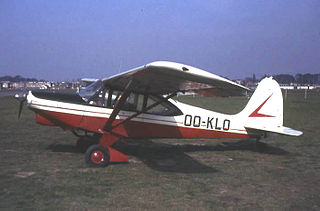The Aeronca Model 9 Arrow was a low-wing all-metal cabin monoplane with retractable landing gear. It was marketed to returning pilots from World War II and unveiled in 1947 but never went into production.

The Agusta AZ.8L, or Agusta-Zappata AZ.8L, was an Italian airliner prototype first flown on 9 June 1958. It was of conventional low-wing monoplane configuration with tricycle undercarriage and all-metal construction. Filippo Zappata's design grew out of a twin-engined transport designated AZ.1 that was never built.

The I-11 was a two-seat civil utility aircraft manufactured in Spain in the 1950s. Originally designed by the Spanish aircraft company Iberavia, its first prototype flew on 16 July 1951. It was a low-wing monoplane of conventional configuration with fixed, tricycle undercarriage and a large, bubble canopy over the two side-by-side seats. Flight characteristics were found to be pleasing, but before plans could be made for mass production, Iberavia was acquired by AISA.
The Auster Avis was a four-seat light aircraft developed from the Auster Autocrat. It featured a redesigned fuselage incorporating four doors and a circular cross-section towards the tail, new undercarriage, and new wing flaps. It was planned in two versions, the Mk 1 for civil use, and the Mk 2 for military and air ambulance duties. However, only two prototypes were built, and Auster abandoned the project in favour of the Auster J-5 Autocar.

The CAB GY-30 Supercab was a two-seat light aircraft built in France in 1954, as a further development of the CAB Minicab. The design was performed by Yves Gardan, a onetime employee of French aeronautical company SIPA. Changes incorporated in the Supercab included a more powerful engine, greater wingspan, manually retractable undercarriage, and slotted flaps that replaced the split flaps of the Minicab.

The Boisavia B.60 Mercurey was a series of four-seat light aircraft developed in France shortly after World War II.
The Boisavia B.260 Anjou was a four-seat twin-engine light aircraft developed in France in the 1950s. It was a low-wing cantilever monoplane of conventional configuration with retractable tricycle undercarriage. Intended by Boisavia as a touring aircraft, it did not find a market and only the single prototype was constructed. At this point, the firm sold the design to SIPA, which modified the design and re-engined it with Lycoming O-360 engines, but found that they could not sell it either. At a time when the twin-engine light plane market was already dominated by all-metal American aircraft, the Anjou's fabric-over-tube construction was something of an anachronism, and all development was soon ceased. Plans to develop a stretched version with three extra seats and Potez 4D engines were also abandoned.

The Brochet MB.80 was a two-seat light aircraft developed in France in the early 1950s.
The Brochet MB.100 was a three-seat light aircraft developed in France in the early 1950s.

The Call-Air Model A is an American two- to three-seat utility aircraft designed by the Call brothers and built by the Call Aircraft Company, later developed into a successful line of agricultural aircraft.
The Brochet MB.120 was a two-seat light aircraft developed in France in the 1950s.

The Colonial Model C-1 Skimmer was an American small single-engined amphibian flying boat built by the Colonial Aircraft Corporation. It was the start of a line of very similar aircraft designed by David Thurston.

The Piaggio P.148 was a 1950s Italian two-seat primary or aerobatic training monoplane designed and built by Piaggio Aero.

The Macchi MB.308, later Aermacchi MB-308, was a light aircraft produced in Italy in the late 1940s.
The Partenavia P.55 Tornado was a 1950s Italian high-performance competition and touring monoplane built by Partenavia. The Tornado was a small mid-wing cantilever monoplane with a retractable tricycle landing gear. The aircraft was powered by a nose-mounted Lycoming O-320 piston engine.

The SAI KZ IV was a light twin-engined aircraft first built in Denmark in 1944 for use as an air ambulance.

The SAI KZ VII Lærke was a light utility aircraft built in Denmark shortly after the Second World War. Based on the SAI KZ III air ambulance, the KZ VII was a strut-braced, high-wing monoplane of conventional design with an enclosed cabin for four seats. Fifty-six aircraft were built, and another 22 partially completed aircraft were destroyed in a factory fire in 1947. The Danish Air Force operated 10 of the type as trainers between 1950 and 1977.

The SECAN SUC-10 Courlis was a French high-wing touring monoplane designed and built by Société d'Etudes et de Construction Aéronavales (SECAN), a branch of the automobile company Société des Usines Chaussons. The aircraft had problems with the engine installation and only 144 were built, some without engines and were scrapped.
The Taylorcraft Model 20 Ranch Wagon was a four-seat cabin monoplane designed and built by Taylorcraft Aircraft as a development of the earlier experimental Model 18. The Model 20 was constructed of moulded fibreglass over a tubular framework. It had a conventional landing gear and a nose-mounted 225 hp (168 kW) Continental O-470-J engine.

The Ambrosini Rondone is an Italian-designed two/three-seat light touring monoplane of the early 1950s.













